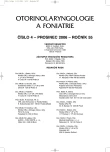Following the Interaction between Parent and Child in the Treatment of Speech Disorders
Využití sledování interakce rodič – dítě v léčbě poruch řeči
Cílem práce bylo programově využívat potenciál rodiny v terapii poruch řeči. V předloženém článku popisuji svá pozorování a zkušenost v souvislostech s literárními zdroji. Vycházím z metody videotréninku a z rodinné terapie. Převážně intuitivní, neuvědomovaný proces (1), v němž rodiče dětem předávají schopnost řeči, lze podrobit mikroanalýze. Společným rozborem obrazu se lze terapeuticky dotknout podvědomých vodítek, jimiž se řídí rodičovské chování k dítěti. Ve foniatrické ambulanci jsem u 28 rodin užila videotrénink v terapii rozličných poruch řeči. Základem práce je zpomalená a zastavovaná videonahrávka a rodinně terapeutický přístup. Pracujeme na kontaktu, naladění (tuning in), příjmu iniciativ. Proces předávání řeči podrobujeme mikroanalýze. Ukazuje se, že způsob interakce rodičů a stav vývoje dětské řeči spolu souvisí cirkulárně. Zvažuji vztah tradované potřeby stimulace vývoje řeči a přestimulování (overstimulating).
Pracuji s tím, že předávání řeči dítěti rodiče převážně dělají nevědomě. Má-li dítě poruchu řeči, je užitečné, aby rodiče svou kompetenci posílili zkušeností z mikrovideoanalýzy interakce. Jazyk videotréninku navíc skýtá možnost komunikovat mezi profesionály svou zkušenost s vlivem rodiny na vývoj řeči dítěte.
Klíčová slova:
interakce s dítětem, terapie poruch řeči, videotrénink, kontakt, stimulace.
Authors:
Z. Hánová
Authors‘ workplace:
ORL klinika FNKV, foniatrická ambulance, Praha
přednosta doc. MUDr. A. Hahn, CSc.
Published in:
Otorinolaryngol Foniatr, 55, 2006, No. 4, pp. 213-216.
Category:
Comprehensive Reports
Overview
The work was intended to take advantage of the family potential in the therapy of speech disorders. In a phoniatric outpatient office the authors employed video training in the therapy of various speech disorders. The author’s experience has been described. The work was based on a slowed down and stopped video recording and the family-based therapeutic approach. The tactic makes use of the contact, tuning in and acceptance of the family initiative. The process of speech transfer is subjected to microanalysis. It has become apparent that the mode of interaction of the parents and the state of development of the child’s speech is in a circular connection. The author considers the relation of traditional need of stimulation of speech evolution and overstimulation.
The author maintains the hypothesis that the speech transfer from the parents is mostly unintentional. If the child suffers from a speech disorder, it becomes useful for the parents to improve their competence by experience from micro video analysis of interaction. The langue of video-training, moreover, provides the opportunity of communication between professionals by their experience in the influence of family on the evolution of the child’s speech.
Key words:
interaction with the child, speech disorder treatment, video training, contact, stimulation.
Labels
Audiology Paediatric ENT ENT (Otorhinolaryngology)Article was published in
Otorhinolaryngology and Phoniatrics

2006 Issue 4
Most read in this issue
- Traumatic Perforation of Eardrum
- Herpes Zoster Oticus
- Clinical Anatomy of the Epitympanum
- Possibilities of 24-hour pH-metry of Upper Esophagus in the Diagnostics of Esophageal-Pharyngeal Reflux
